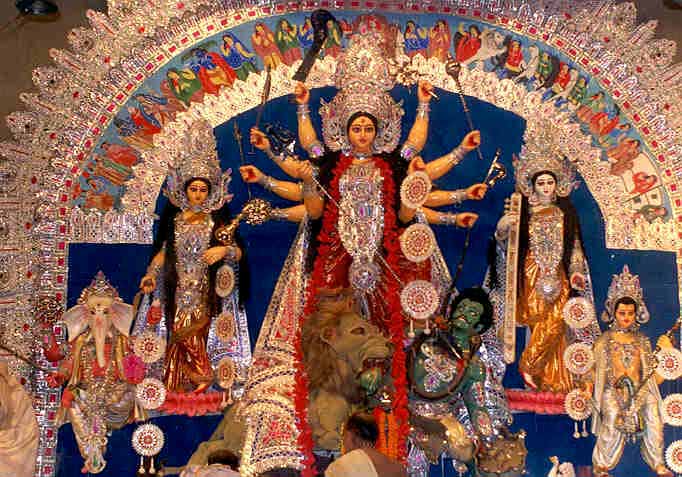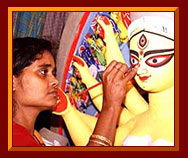 Pundaal Decoration during Durga Puja
Pundaal Decoration during Durga Puja An Artist decorating the Idol of Maa Durga
An Artist decorating the Idol of Maa Durga Maa Durga killing Mahishasur
Maa Durga killing Mahishasur
Origin of Durga - The Mythology.
Devi is the great goddess of the Hindus,the consort of Shiva and she is worshiped in various forms corresponding to her two aspects: benevolence and fierceness. She is Uma, "light"; Gauri, "yellow or brilliant"; Parvati, "the mountaineer"; and Jagatmata, "the-mother-of-the-world" in her milder guise. The terrible emanations are Durga "the inaccessible"; Kali, "the black"; Chandi, "the fierce"; and Bhairavi, "the terrible."
Significance of Durga Puja
|
Meaning Of Durga
Durga is perhaps the most widely worshiped deity of Shakti. Maa Durga's divine characterization include entire Devibhagavatham is dedicated to her. Durga means one who is difficult to approach. However since she is the mother of universe she is the personification of tender love, wealth, power, beauty and all virtues.
Implications Of The Idol
The complete image of Goddess Durga represent destruction of evil and protection of good and reflects the point that in order to become divine one should keep one's animal instincts under control. Thus, by worshiping Durga the idea of ruthless destruction is invoked to annihilate all the desires and unfold divinity.
Its Connotation
ln Bengal, Goddess Durga is worshiped for nine days. In South India, an altar decorated with a stepped platform and filled with small images of gods, animals,birds,and other beings, animate and inanimate, is worshiped for nine days. This altar is known as the Kolu. People re-dedicate themselves to their profession. On this day, a child also begins to learn the alphabet in a ceremony known as aksarabhyasa. This day marks the beginning of any type of learning. One offers gifts to one's teachers, seeks their blessings,and prays for success in one's new endeavors.




No comments:
Post a Comment